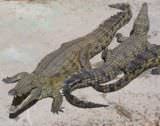Crocodiles have long and pointed, V-shaped snouts while alligators have rounded, U-shaped snouts. Other differences include the shape of their jaws and hind legs. Their behavior is also starkly different, with crocs being more aggressive than gators.
Comparison chart
Differences in Physical characteristics
Snout
Alligators have a wide "U"-shaped, rounded snout (like a shovel), whereas crocodiles tend to have longer and more pointed "V"-shaped noses.
Jaw
In alligators, the upper jaw is wider than the lower jaw and completely overlaps it. Therefore, the teeth in the lower jaw are almost completely hidden when the mouth closes, fitting neatly into small depressions or sockets in the upper jaw. This is called an "overbite". The large fourth tooth on each side of the alligator’s lower jaw fits into a socket in the upper jaw.
However, in crocodiles, the upper jaw and lower jaw are approximately the same width, and so teeth in the lower jaw fit along the margin of the upper jaw when the mouth is closed. Therefore, the upper teeth interlock (and "interdigitate") with the lower teeth when the mouth shuts. The large fourth tooth on each side of the crocodile's lower jaw projects outside the snout when the mouth is closed.
Hind legs
Crocodiles have a jagged fringe on their hind legs and feet; alligators do not. Alligator have webbed feet; crocodiles do not.
Size
The American alligator is the larger of the two species of alligator and typically ranges from 6-12 ft but can grow up to 19 ft. The Chinese alligator is smaller, typically about 5 ft with a maximum length of about 7 ft.
Crocodiles are the largest and heaviest of present-day reptiles. The Nile crocodile (Crocodylus niloticus) of Africa and the estuarine (or saltwater) crocodile (C. porosus) of Australia are the largest species; they can grow up to 20 ft in length and weigh over 1,000 kg (about 2,200 pounds). The smallest species, the smooth-fronted caiman (Paleosuchus) and the dwarf crocodile (Osteolaemus tetraspis), reach about 6 feet in length as adults.
Differences in behavior
Differences in behavior are also apparent. Most people regard crocodiles as more aggressive than alligators, and this is true of some species. When cleaning alligator pools, some zookeepers can tread on alligators without eliciting a response, though crocodiles almost invariably react aggressively.
Habitat
Alligators prefer freshwater while crocodiles can better tolerate brackish water because they have functioning salt glands on their tongue. This allows crocodiles to easily filter out salt. While alligators also have these structures, they appear to have lost the ability to use them for excreting significant amounts of salt and hence preferring to stay in freshwater areas.
More Pictures
Conservation
South America's largest crocodile, the fierce but reclusive Orinoco crocodile — is on the verge of extinction. This New York Times article shines a light on conservation efforts for this species.
Life span
Crocodiles live for 35-75 years with some known to live even longer. The longest know age of alligators is in the 80s.[1] One interesting fact about crocodiles and alligators is that they do not exhibit senescence i.e., biological aging. [2]
Rather than dying from old age, species with negligible senescence will die from other causes, such as illness or predators. Alligators and crocodiles will continue to grow for their entire lives, and after a certain point can no longer feed themselves to keep up with their growing metabolisms. Thus, their bodies are no longer energy efficient and they pass away due to starvation.
Taxonomy
Crocodiles and alligators are both reptiles belonging to the order Crocodilia, who have been in existence for over 80 million years.








 Amphibian
Amphibian  Dolphin
Dolphin  Turtle
Turtle  Slug
Slug  Tiger
Tiger  Cheetah
Cheetah
Comments: Alligator vs Crocodile
Anonymous comments (5)